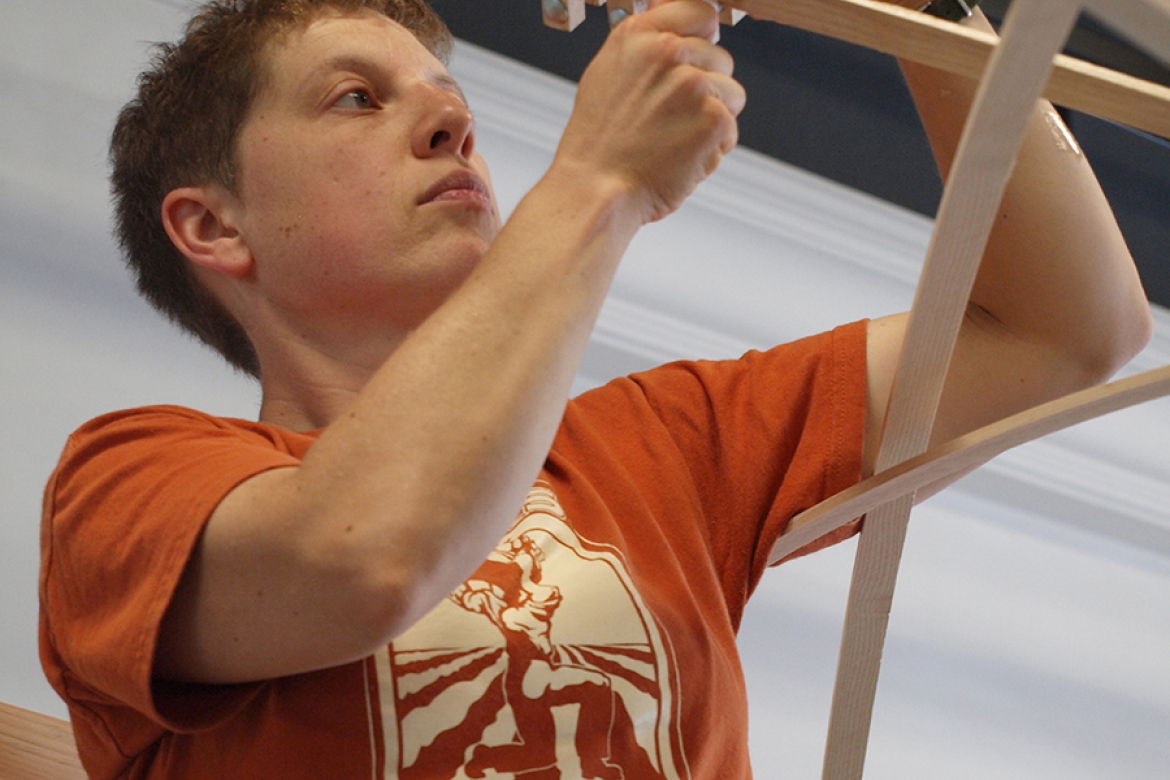Gina Siepel, Art Studio

“I like that Mount Holyoke students are integrating their liberal arts curiosities and criticality with their artistic work.”
Name: Gina Siepel
Title: Lecturer in Studio Art Foundations
Department: Art Studio
Areas of study: Sculpture, drawing and painting, interdisciplinary studio art
Research focus: Gina Siepel’s interdisciplinary work explores cultural understandings of nature, gender and American history, through the production of objects and collaborative experiments in public spaces. Her recent exhibitions include the deCordova Museum and Sculpture Park, Colby College Museum of Art, Marlboro College, Smith College, Flux Factory and the A.P.E. Gallery. Siepel has been a contributing guest artist at Mildred’s Lane and an artist-in-residence at Sculpture Space. She has received funding from the Massachusetts Cultural Council, the Berkshire Taconic Community Foundation, the Puffin Foundation and the Northampton Arts Council.
What drew you to your area of study: When I was a kid, I wanted to be an artist or an inventor. Now I use my art to do a bit of both. Art is a wide-open field that incorporates many forms of inquiry and exploration, and for me, the most important thing is that I can explore my curiosity in a way that always centers on hands-on practice and experimentation. I’m particularly drawn to interdisciplinary practice because it allows me so much freedom to integrate contemporary issues, collaborative models and interests from other fields into my studio practice.
What appeals to you about being a professor at Mount Holyoke: First and foremost, I appreciate the atmosphere of community and diversity at Mount Holyoke, where I have felt very welcome and where I have enjoyed getting to know people from many different backgrounds and parts of the world. Secondly, I studied at an art school, where I received an intensive training in skills, materials and visual thinking. But I got to a certain point where I needed more intellectual development in order to understand the broader context of art making, and what I could do with my art that was meaningful. I like that Mount Holyoke students are asking these questions from the very beginning, and integrating their liberal arts curiosities and criticality with their artistic work.
What do you like about teaching: The thing I most enjoy about teaching is getting to know students, who constantly surprise, challenge and astonish me with ideas and solutions. I have never really stopped being a student myself, and teaching allows me to engage the fundamental questions of artistic practice collaboratively with students, constantly challenging my own assumptions and enlarging my understanding. Art is a field where we learn by doing, and I am always learning along with the class.
What do you look forward to at Mount Holyoke: As an artist, I frequently collaborate with all kinds of others — other artists, scientists, community members, fishing guides, even birds. It’s natural to me to involve others in the development of inquiry and process and I look forward to collaborating with many members of the Mount Holyoke community in the future.
What are your proudest accomplishments, academic or other: I’m proud to have worked on projects that have allowed me to go deeply into a practice of making while also engaging issues and communities that really matter to me. As much as I love being in the studio and digging deeply into formal and material issues, I don’t want to use my art as a means of turning away from the world. I have also built eight fully functional wooden boats!
Favorite previous work/volunteer/research/teaching experiences: I spent almost 20 years in the theater, designing, building and painting sets all over New York City and New England. I loved the challenges, constant surprises and laughter involved in this work. A few highlights involved building a throne out of money for a rap video, hanging a full-sized oak tree upside down in a theater and building a grand piano that weighed only 27 pounds.
Favorite things about the campus and region so far: I’ve lived in the region for seven years and I love that I can have a rich cultural and artistic community and also spend a lot of time outdoors. This part of New England has a great deal of ecosystem variety and I enjoy exploring as much of it as I possibly can.
What was your favorite class as an undergraduate: Honestly, it was Foundation Drawing, which is why I am so excited about teaching foundations and drawing!
What do you like to do when you are not working: Much of my time is spent in my studio, where I am often at work on new projects. Beyond that I can often be found in the forests and swamps of the Hilltowns with binoculars in hand, birding. Or just hiking or swimming. I also spend a lot of time working on my 115-year-old house, and spend time with my partner, family and friends.
Favorite book, author, music, movie/TV: I barely ever watch TV or movies. I generally prefer the alternate reality of novels over movies. Probably the most important book to my art practice is “Walden” by Henry David Thoreau, which I have a lovingly critical relationship to. It has been a big influence. I read a lot of contemporary books on nature and ecology. Most recently I read “Canoe Paddles, A Complete Guide to Making Your Own,” by Graham Warren and David Gidmark. It combines a discussion of craft and materials with historical analysis, digging into the indigenous North American origins of the form and its evolution through the colonial and modern periods.
Read more about Gina Siepel.